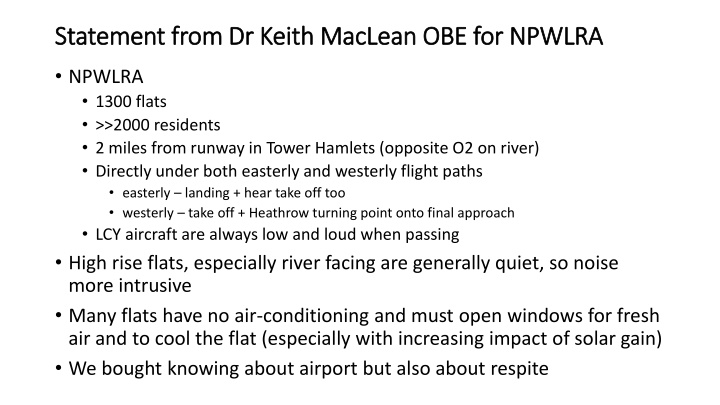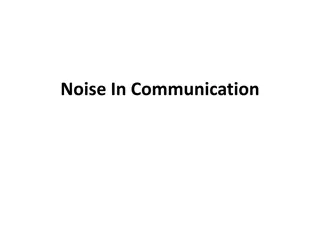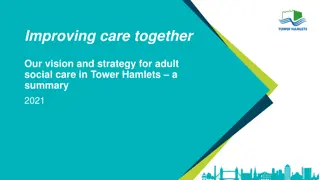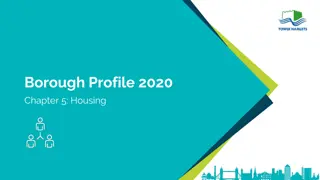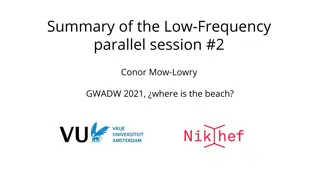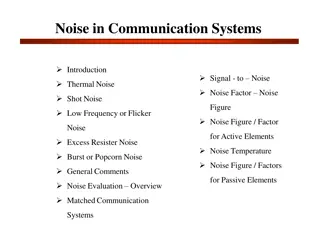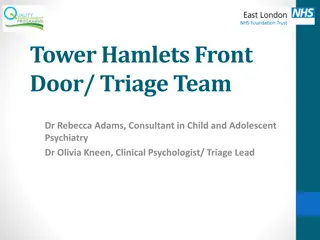Concerns Regarding Airplane Noise Impact on Residents in Tower Hamlets
Dr. Keith MacLean OBE provides a statement on the impact of airplane noise on over 2000 residents living in 1300 flats within a 2-mile radius of a London airport in Tower Hamlets. The residents face challenges with noise disturbance from easterly and westerly flight paths, with proximity to both landing and take-off routes. Lack of air-conditioning in many flats necessitates open windows, exacerbating the noise issue. Dr. MacLean emphasizes the need for stakeholder considerations and the importance of qualitative factors in addressing community concerns.
Download Presentation

Please find below an Image/Link to download the presentation.
The content on the website is provided AS IS for your information and personal use only. It may not be sold, licensed, or shared on other websites without obtaining consent from the author.If you encounter any issues during the download, it is possible that the publisher has removed the file from their server.
You are allowed to download the files provided on this website for personal or commercial use, subject to the condition that they are used lawfully. All files are the property of their respective owners.
The content on the website is provided AS IS for your information and personal use only. It may not be sold, licensed, or shared on other websites without obtaining consent from the author.
E N D
Presentation Transcript
Statement from Dr Keith MacLean OBE for NPWLRA Statement from Dr Keith MacLean OBE for NPWLRA NPWLRA 1300 flats >>2000 residents 2 miles from runway in Tower Hamlets (opposite O2 on river) Directly under both easterly and westerly flight paths easterly landing + hear take off too westerly take off + Heathrow turning point onto final approach LCY aircraft are always low and loud when passing High rise flats, especially river facing are generally quiet, so noise more intrusive Many flats have no air-conditioning and must open windows for fresh air and to cool the flat (especially with increasing impact of solar gain) We bought knowing about airport but also about respite
Statement to Inquiry (focus on air noise and respite) (focus on air noise and respite) ES is very clinical and theoretical (not the first time or the only one!) For many - written in inaccessible language Selective and unhelpful use of statistics, e.g. The danger of the 'average simple, often useful, but can be deceptive levelising masks the variability of data, leads to oversights that can fuel misinformed decisions and propagate misleading narratives Man with head in oven and feet in freezer On average he d found a comfortable temperature! Logarithmic scales (eg dB) also deceptive and need interpretation Good to fit big differences on one graph Difficult to interpret, especially changes +3 = x2; +10 can be x10, or x100 (sound pressure or sound intensity respect.) Has the Inquiry been given the information to know which is relevant here and, more importantly, how it relates to what those affected will actually hear?
Need to account for stakeholders wider concerns Need to account for stakeholders wider concerns Stakeholder engagement should consider and assess appropriate qualitative and subjective factors not just quantitative ones In ES language, I am a residential receptor here officially to represent a few thousand other residential receptors unofficially probably many more We are also living examples of those (very) likely to be annoyed ! but do not feel listened to, or that our views are reflected in the conclusions of the ES NPW not even on maps (ES or LCY Annual Performance Reports) Bickerdike Allen are still using same version as in 2000 s before NPW (and much more) built Hopefully population statistics and similar data used in the ES are more up to date! I m a scientist, but this is not an academic response what I will say is heavily weighted to observation of reality, rather than theoretical modelling reflects how we are already impacted and what our concerns are.
Noise assessment Should not just be about volume (deciBels) Experience from 30 years in energy industry with power cuts, the perceived disturbance/annoyance not only relates to duration, e.g. how long an outage lasts each time or cumulatively but importantly also, to frequency and distribution patterns. Now a regulatory requirement to monitor and publish all relevant data and show adhrenece to ever stricter targets. ES heavily weighted towards the single dimension of sound volume It also shows other useful data but does not appear to give them any/much weighting in the overall assessment particularly with regard to the disputed respite periods on Saturday and in the early morning, these other factors could help the assessment to better reflect real issues of annoyance and/or sleep disturbance?
Assessment of scale and significance of changes in air noise Assessment of scale and significance of changes in air noise The ES states: 8.3.97 There is no clearly accepted method of how to rate the scale of the effect and accordingly this has been determined based on professional judgement. Some guidance has however been provided in the PPGN which states among What factors influence whether noise could be a concern? the following: In cases where existing noise sensitive locations already experience high noise levels, a development that is expected to cause even a small increase in the overall noise level may result in a significant adverse effect occurring even though little or no change in behaviour would be likely to occur. With this acknowledged uncertainty in methodology, it seems inappropriate to focus on only one metric, especially one which only shows negligible impact, and to exclude others (e.g. N65, or the count of the highly sleep disturbed population) which appear to signal a non-negligible change in impact. At the very least, the ES should give a clear justification
Number of people experiencing incidents higher than 65dB (also correlates with annoyance, CAA) In 2031 DC day (Exeter) >50% increase to DM and B >40% to DM, >400% to B In 2031 DC weekend day (York) ~100% increase to DM and B >150% to DM, >600% to B Potential 50% increase, but hope only 5-10% with quieter aircraft (x6 NPW)
Other important characteristics of noise Irritating (scale is relative) (high ranking for most people jet engines, nails on blackboard, snoring very relevant to sleep disturbance,) Incessant nature - many times an hour, every day, every week and month, year in year out Examples: Hammering loud, frequent but short duration - how would ES treat that? Mosquito another example which can cause significant sleep disturbance NOT loud, but very annoying sound; only going to get louder as it approaches its victim, days of discomfort to follow, and it or another one will be back again unless something is done So, what can be done with LCY noise?
Some thoughts for (partial) remedy Volume (is partially addressed) proposed quieter planes Insulation look at triggers and measures that reflect more than just levelised volume NPW eligibility? Little else available for other factors other than to maintain/reduce number of early/late planes (not increase!) maintain existing respite from early and late flights ideally increase respite with flightpath diversity
Conclusions Not against the development of the airport Accept that flight numbers will increase However, the increase must be mitigated to maintain the founding principle of balancing economic benefit and the impact on residents Recognise the increased importance of respite with increasing flight numbers Subjective views of real people, rather than just those of modelled, theoretical receptors are important fingernails on blackboard, not readily measurable but very real Ask Inquiry to: challenge reliance on a single measure of impact/annoyance (predominantly LAeq,16h) give more weight to changes in the frequency of significant air noise events, e.g. N65 timing of flights particularly to avoid sleep disturbance and impact on weekend respite
Site visits Not Saturday afternoon, unless as baseline East and west wind Take-off and landing New and old aircraft does it make a discernible difference? consider a blind assessment of aircraft type Assess impact from high rise flats Please, keep listening to affected people!
